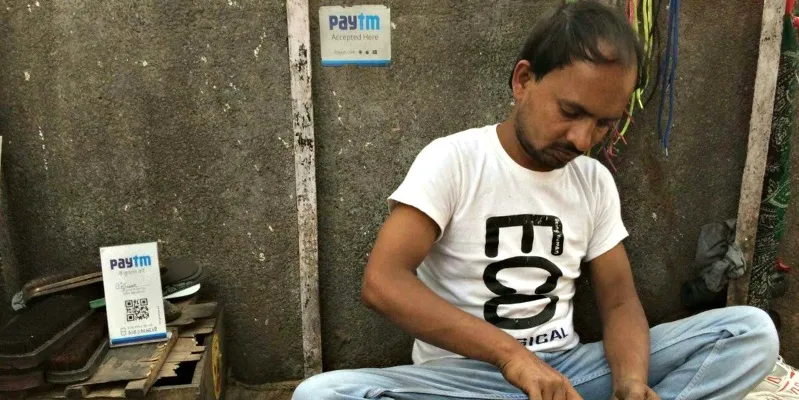Will BharatQR's launch hit the likes of Paytm and MobiKwik?
With a common QR code being launched today for card network operators, could wallet companies see a dip in their rising popularity in the offline retail sector?
BharatQR, a common QR code developed by major card network companies MasterCard and Visa, and National Payment Corporation of India (NPCI), which runs RuPay, will be launched today. This will involve every merchant in the country having a unique QR code, allowing users with debit or credit cards to pay directly from their phone, through just a scan.
Since the government's call for demonetisation of high-value currency notes early November last year, we have seen wallet companies aggressively push offline QR cards on merchants to increase their offline presence. So much so that in December, Vijay Shekhar Sharma, Founder-CEO of Paytm, claimed that almost 65 percent of his revenues came through offline channels of payments.

But does BharatQR -- seen as a big move by the government to promote digital payments in the retail sector -- ensure the card network operators' relevance in the face of rising competition from wallet companies? Before we dwell on the argument, let’s go back to the basics first.
Sharad Sharma, Co-founder of Indian Software Product Industry Round Table (iSPIRT), whose team was instrumental in the development of Unified Payments Interface (UPI), and BHIM app, says,
It might be government-mandated, but the process hasn’t started yet. For the moment, the government has just embraced the idea for interoperability for QR codes. BharatQR, at present, is only inter-operable amongst the card networks. The idea is good and we should take it forward. But the ultimate goal should be a QR code for merchants that is inter-operable for not just credit and debit cards of RuPay, Visa, MasterCard, but also for UPI and wallets.
So, what does BharatQR hit?
Clearly, as an offering, BharatQR removes the users' dependency on cards, and would eventually help disrupt the card network’s age-old business of issuing cards and setting up expensive point-of-sale (PoS) terminals.
For banks too, it would mean spending less, since neither activating PoS machines for merchants nor issuance of cards for customers would be needed.
When he spoke to YourStory in the past, Abhijit Bose, Co-founder and CEO of PoS and payments services company Ezetap, had admitted that times ahead were tough for legacy PoS deployers, with newer innovative business models being built around payments in the country.
We spoke to him again and he explains how in the wake of the demonetisation announcement, wallet players have aggressively pushed for more innovative solutions to capture the offline payments market. He adds,
It was thought necessary by the government that card networks also have a fair standing in digital payments. So it’s a wake-up call for the card networks. We don’t know whether cards will survive or not, but at least BharatQR code for now provide standardisation and better scalability of terminals for card networks.
Is it card companies vs. wallets now?
So is BharatQR then a firm push by card operators like Visa, MasterCard, and RuPay to get a market share of the increased cashless transactions in the country? Bala Parthasarathy, Co-founder and CEO, MoneyTap, seems to think so. He says,
There might be some steam in what you say because the details of BharatQR are still sketchy until the launch. While being a more practical option, thanks to Paytm and the other m-wallet companies, QR codes have become a proven mode of payments as well.
And while details on interoperability still remain vague, data shows that QR codes' practicality is a significant reason for increased interest from banks and card networks. According to RBI data, by the end of December, the country had more than 1.7 million PoS machines, while wallet players like MobiKwik alone had close to 1.4 million offline QR codes deployed to merchants. Paytm has claimed in the past to be on road of deploying two million QR codes by the end of this fiscal year.
In the past, Paytm had rolled out its app-based PoS feature, which allowed small and medium-sized merchants to accept all kinds of card payments, including RuPay, Visa, MasterCard, and Maestro. But within a day it rolled back the feature citing security concerns, with inside sources claiming that network majors Visa and MasterCard along with a few banks had raised concerns with the RBI over the launch.
An inside source on the matter said the wallet companies and payment mechanisms like UPI have given card networks--who make revenues on age-old transaction costs--ample cause for worry. Operating mostly on a limited licence, and having already lost out in China, the international card network companies do not want to lose out on a growing economy like India.
But others argue against comparing BharatQR with wallet companies' PoS presence. Sharad says,
It is a wrong idea to compare BharatQR with the likes of Paytm, because, first, the two will merge under one QR, and secondly, the latter already has a strong acceptance with merchants and users. At the end of the day, it is the ease of setting up and usage for merchants and users that drives acceptance.
Abhijit agrees, adding that people should not view every fintech product that is launched to be a game-changer in the market. Pointing out that developed countries like the US are still dependent on cards, he says the sentiment shouldn’t be that QR code is the next big thing, but rather that it is one more way of increasing digital acceptance in the country.
The ambiguity surrounding the question of interoperability, however, does bother certain players in the market.
Vinit Singh, Chief Business Officer of MobiKwik, says,
We would also like the government to acknowledge the work wallet companies such as us have done on the ground to ensure widespread access to mobile payments, to help millions in getting onto our payment network, while assuring them of the security, and also launching customised apps in Indian languages. Going forward, we are confident that the government will consider including wallets in India QR.
For the merchant, this would mean just slapping another sticker outside his shop saying he accepts payments through BharatQR.
Last week, the RBI had released a draft circular on transactions and Merchant Discount Rates (MDR), introducing slabs for QR-based payments, taking on a GST outlook and charging merchants MDRs based on their annual turnover.
But for the consumer, it all boils down to whether the latest kid on the digital payments block is cheap, seamless, and hassle-free. While many may say Prime Minister Narendra Modi’s push worked in the favour of downloads for BHIM app, one has to agree its simplified user experience also contributed to its popularity.
Some big questions loom large around BharatQR's launch: will it replicate the same acceptance facilitated by wallet companies with their card QRs? How soon will the solution be inter-operable with mobile wallets and UPI? How will banks lure merchants to accept it, and will BharatQR be able to give a seamless experience to the users? We hope to know the answers to these in the coming weeks.
(At the time of publishing this article, Paytm did not respond to queries sent by YourStory.)







